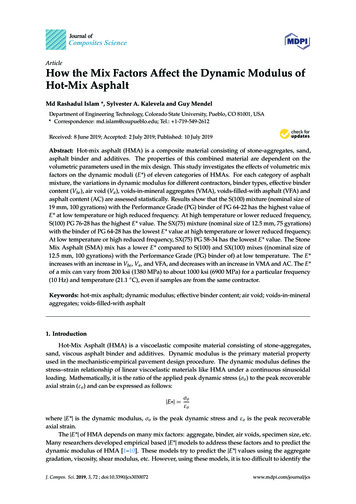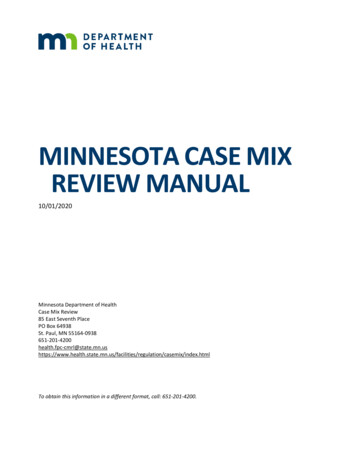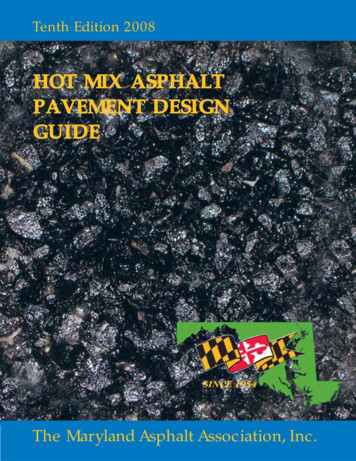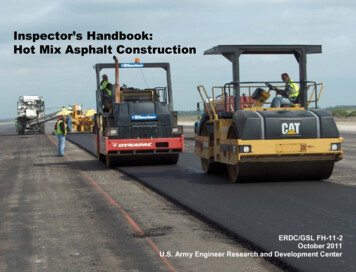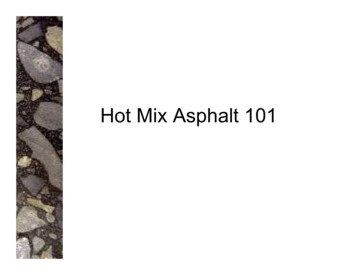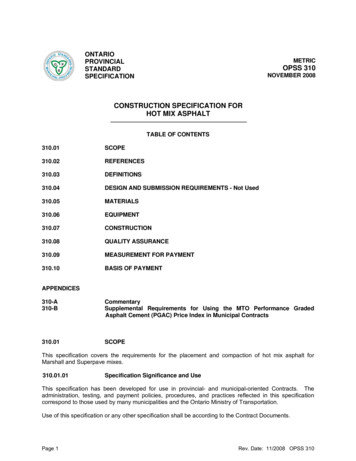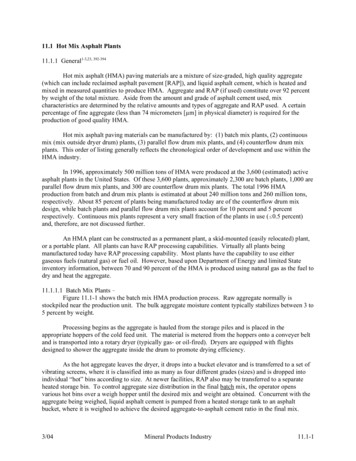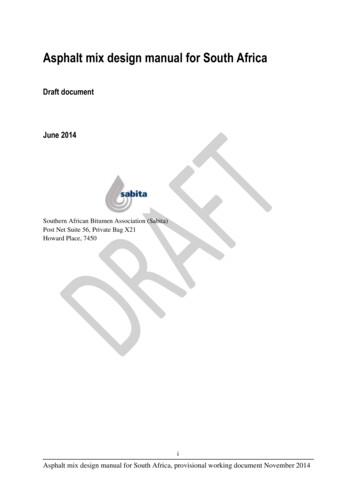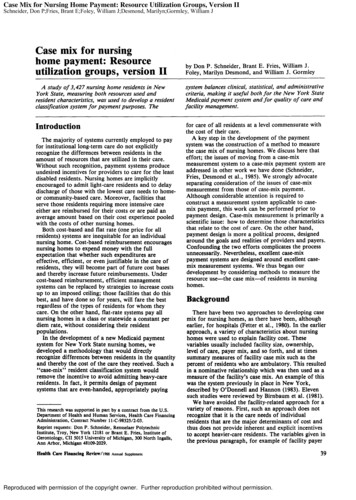
Transcription
Case Mix for Nursing Home Payment: Resource Utilization Groups, Version IISchneider, Don P;Fries, Brant E;Foley, William J;Desmond, Marilyn;Gormley, William JCase mix for nursinghome payment: Resourceutilization groups, version IIby Don P. Schneider, Brant E. Fries, William J.Foley, Marilyn Desmond, and William J. GormleyA study of 3,427 nursing home residents in NewYork State, measuring both resources used andresident characteristics, was used to develop a residentclassification system for payment purposes. Thesystem balances clinical, statistical, and administrativecriteria, making it useful both for the New York StateMedicaid payment system and for quality of care andfacility management.Introductionfor care of all residents at a level commensurate withthe cost of their care.A key step in the development of the paymentsystem was the construction of a method to measurethe case mix of nursing homes. We discuss here thateffort; the issues of moving from a case-mixmeasurement system to a case-mix payment system areaddressed in other work we have done (Schneider,Fries, Desmond et al., 1985). We strongly advocateseparating consideration of the issues of case-mixmeasurement from those of case-mix payment.Although considerable attention is required toconstruct a measurement system applicable to casemix payment, this work can be performed prior topayment design. Case-mix measurement is primarily ascientific issue: how to determine those characteristicsthat relate to the cost of care. On the other hand,payment design is more a political process, designedaround the goals and realities of providers and payers.Confounding the two efforts complicates the processunnecessarily. Nevertheless, excellent case-mixpayment systems are designed around excellent casemix measurement systems. We thus began ourdevelopment by considering methods to measure theresource use-the case mix-of residents in nursinghomes.The majority of systems currently employed to payfor institutional long-term care do not explicitlyrecognize the differences between residents in theamount of resources that are utilized in their care.Without such recognition, payment systems produceundesired incentives for providers to care for the leastdisabled residents. Nursing homes are implicitlyencouraged to admit light-care residents and to delaydischarge of those with the lowest care needs to homeor community-based care. Moreover, facilities thatserve those residents requiring more intensive careeither are reimbursed for their costs or are paid anaverage amount based on their cost experience pooledwith the costs of other nursing homes.Both cost-based and flat rate (one price for allresidents) systems are inequitable for an individualnursing home. Cost-based reimbursement encouragesnursing homes to expend money with the fullexpectation that whether such expenditures areeffective, efficient, or even justifiable in the care ofresidents, they will become part of future cost basesand thereby increase future reimbursements. Undercost-based reimbursement, efficient managementsystems can be replaced by strategies to increase costsup to an imposed ceiling; those facilities that do thisbest, and have done so for years, will fare the bestregardless of the types of residents for whom theycare. On the other hand, flat-rate systems pay allnursing homes in a class or statewide a constant perdiem rate, without considering their residentpopulations.In the development of a new Medicaid paymentsystem for New York State nursing homes, wedeveloped a methodology that would directlyrecognize differences between residents in the quantityand thereby the cost of the care they received. Such a"case-mix" resident classification system wouldremove the incentive to avoid admitting heavy-careresidents. In fact, it permits design of paymentsystems that are even-handed, appropriately payingThis research was supported in part by a contract from the U.S.Department of Health and Human Services, Health Care FinancingAdministration, Contract Number ll-C-9832S/2-03.Reprint requests: Don P. Schneider, Rensselaer PolytechnicInstitute, Troy, New York 12181 or Brant E. Fries, Institute ofGerontology, CII SOlS University of Michigan, 300 North Ingalls,Ann Arbor, Michigan 48109-2029.Health Care Financing Revlew/1988BackgroundThere have been two approaches to developing casemix for nursing homes, as there have been, althoughearlier, for hospitals (Fetter et al., 1980). In the earlierapproach, a variety of characteristics about nursinghomes were used to explain facility cost. Thesevariables usually included facility size, ownership,level of care, payer mix, and so forth, and at timessummary measures of facility case mix such as thepercent of residents who are ambulatory. This resultedin a nominative relationship which was then used as ameasure of the facility's case mix. An example of thiswas the system previously in place in New York,described by O'Donnell and Hannon (1983). Elevensuch studies were reviewed by Birnbaum et al. (1981).We have avoided the facility-related approach for avariety of reasons. First, such an approach does notrecognize that it is the care needs of individualresidents that are the major determinants of cost andthus does not provide inherent and explicit incentivesto accept heavier-care residents. The variables given inthe previous paragraph, for example of facility payerAnnual SupplementReproduced with permission of the copyright owner. Further reproduction prohibited without permission.39
mix as a predictor of cost and thereby a case-mixsurrogate, are representative of this type of problem.Second, many of the measures that might be used arethose cost-related items that might well be controlled.Thus, their inclusion in a rate-setting formula is asophisticated, indirect return to cost reimbursementrather than a prospective rate-setting approach. Third,nursing homes would still have to cope withdifferences in the intensity of care required by theirresidents, and these differences over time or acrossfacilities would not be recognized outside of thosecorrelated with facility characteristics.The second generic approach to define case mixsolves these problems by directly examining theresidents in a facility. The logic for this approach isbased on the industrial engineering concept of the"product" of a firm. If the types of residents in afacility or the level of their needs can be specified,then a facility's case mix is the amalgamation of thesemeasures for all its residents. The best knownapplication of this approach is the diagnosis-relatedgroups (DRG's) system for acute care hospitals.In long-term care there have been several residentlevel case-mix measure and resident classificationsystems suggested. Some of the work we consideredincluded systems developed by the Battelle HumanAffairs Research Centers (McCaffree, Wino, andBennett, 1976; McCaffree, Baker, and Perrin, 1979;Cavaiola and Young, 1980), and the State ofMaryland (Deane and Cella, 1981), and the earlierversion of the resource utilization groups (Fries andCooney, 1985). Examples of these approaches are welldocumented in the report to the Health CareFinancing Administration by Stassen and Bishop(1983). Other systems, for example those used forreimbursement determination in Illinois, Ohio, andWest Virginia, define case mix at the resident level,but principally utilized services in this determination;we discuss later our concerns with service-basedapproaches. During or subsequent to the developmentwork described here, other systems have beendeveloped by Weissert et al. (1983), Cameron (1985),the Minnesota Department of Health (1986), Morriset al. (1986), and Arling et al. (1987).Conceptual approachThe goal of the current work was to develop aresident classification system consisting of residentgroups, defined by resident characteristics, whichwould be predictive of nursing home resource use andusable in a payment system. We denote the systemderived "resource utilization groups, version II," orRUG-II. Each part of this goal statement hadimportant implications for the development effort.First, we sought a "classification" or "grouping"system; an alternate approach would lead to an"index" or "rating" system in which a numberrepresenting relative resource use is assigned to eachresident directly . 1 Advantages exist to each approachon conceptual as well as technical grounds. Index(rating) systems can make conceptual sense if they addthe times spent caring for particular residentconditions. Such systems are most often derivedthrough regression or discriminant analysis. Groupingsystems conceptually follow categorization approachesoften seen in biology and medicine. They are derivedthrough analysis of variance and allied statisticaltechniques. We have selected this latter approachbecause of its adeptness in handling interactions, i.e.,the synergistic effects of two or more residentconditions on resource use. For example, we believethat a single condition may not lead to high resourceuse, but may in combination with a second.Following the grouping approach, one can envisiona range of possible systems which on the one extremeclassifies every resident into a separate group and onthe other has all residents in the same group. Bothextremes are inappropriate: the former, althoughrecognizing the differences always seen between anypair of residents, provides no understanding ofresource use; the latter, similar to most currentreimbursement systems, provides little or nodifferentiation of residents. Most current systemsrecognize only the difference between intermediatecare facility (ICF) and skilled nursing facility (SNF)residents. We sought a system between these twoextremes, identifying clusters of residents who haverelatively homogeneous resource use. Clearly, with alimited number of groups there remains substantialdifferences between residents within each group, butthe groups are relatively homogeneous and differentfrom each other.Second, we considered only systems that employedresident characteristics. Based on the work of othersand our own observations, significant explanation ofresource could be expected by recognizing the type offacility (SNF versus ICF), ownership (proprietary,voluntary, governmental), organization (freestandingversus hospital-based), Medicaid occupancy, and soforth (Bishop, Plough, and Willemain, 1980;Shaughnessy et al., 1985). Based on the logicdiscussed in the previous section, all of these possibledefining conditions were considered inappropriate:they did not refer to residents' characteristics, butrather to where residents were and the services theywere provided.Third, we wished to predict actual resource use, atthe level of the individual resident. A potential modelfor this development, the diagnosis-related groups(DRG's), used for case-mix measurement in the acutecare system and the basis for Medicare's prospectivepayment system predict resource use for an entireepisode of care. However, for long-term care, lengthsof stay-and thereby episode costs-are extremelyvariable, with similar residents institutionalized fordays, weeks, or multiple years. Although paying foran episode would be technically feasible and perhapslit should be noted that the RUG-II system utilizes an (activities ofdaily living) index, but only to define patient groups; thus, thissystem remains one of the "grouping" type.40Health Care Financing Reviewii988Reproduced with permission of the copyright owner. Further reproduction prohibited without permission.Annual Supplement
appropriate for financing at the aggregated level of alarge population, practically, and at the level of anindividual nursing facility, this high variability makesit necessary to consider per diem payment systems.The effort here, therefore, focuses on explaining thosecosts specifically associated with the care of a residentin a nursing home for an individual day.Finally, operational implementation in a paymentsystem is feasible only if the case-mix measure isbased on characteristics that are valid, measurable,and reliable, and that can be audited. For example,we found that a resident's functional capability tobathe was highly associated with a facility's practicepatterns: In some, residents taking a bath would haveactive staff assistance regardless of their functionalcapability. It follows that bathing was not a validresident characteristic, even when it could bemeasured reliably.The overall goal led to a set of specific criteria forsystem development. These criteria form three majorcategories: statistical, clinical, and administrative.Statistical criteriaThe major statistical criterion used was a measureof how many of the differences in resource usebetween nursing home residents could be explained bythe resident groups; this proportion is denoted"variance explanation." For example, the pilot RUGsystem (Fries and Cooney, 1985), consisting of 9groups, achieved a variance explanation of 37.8percent-37 .8 percent of the differences in thedependent variable were explained by this system-aninitial target for the current development. Forcomparison purposes, the DRG system, when appliedto all patients in acute care hospitals, has a variancereduction of approximately 30 percent (Cretin andWorthman, 1986), although we caution against thedirect comparison of these numbers. Other statisticalcriteria included measures of the homogeneity of thefinal groups, as measured by their coefficient ofvariation (the group standard deviation divided by thegroup mean) and measures of the differences betweengroup means.Clinical criteriaA system that makes clinical as well as statisticalsense is more likely to be accepted and used in clinicalenvironments. We defined "clinical sense" to meanthat residents within a category had clinical affinity.In our development effort, we were assisted by atechnical panel including clinicians (physicians, nurses,therapists, etc.) as well as administrators, researchers,and health care policy analysts. The charge to thispanel was to help design possible taxonomies ofresidents and new combinations of variables to betried and to assist in understanding analytic results.Initially, we expected that this panel would assistsolely in providing a clinical reality to the derivedsystem. We anticipated that their suggestions,provided interactively with our analyses, would leadHealth Care Financing Reviewll988to an admixture of new possible approaches andsignificant numbers of invalid hypotheses. Althoughthese both did occur, we subsequently found that thisclinical reality provided us with new insight that led toa superior system on statistical grounds as well. Thisresult by itself is important for future studies,emphasizing the need to combine statistical andclinical criteria.Administrative criteria and incentivesClassification systems often are not appropriate forthe particular context in which they might beemployed. For payment applications, often theproblems involve the provision of inappropriateprovider incentives. One such is an incentive to"game" the system: to develop for a resident acharacteristic at little cost to the provider that willresult in increased case-mix payment. An example canbe drawn from the earlier version of the RUG's (Friesand Cooney, 1985), a system developed forretrospective analysis of the differences betweennursing homes' costs. This system used the monitoringof intake and output of fluid to differentiate the twohighest care groups. In addition to making clinicalsense, fluid monitoring acted as a surrogate (later weuse the term "indicator" for such a variable) for thebundle of needs of the sickliest nursing homeresidents. However, for prospective payment, a systembased in part on 110 monitoring would provide asignificant incentive for facilities to game by placingrelatively ill residents on fluid monitoring, especiallybecause monitoring would cause little harm to theresident.Some variables that can be gamed provideappropriate incentives, such as for the provision ofrehabilitation therapies. In the system we developed,rehabilitation services were explicitly included toprovide incentives for their expanded use. Otherservices such as bowel and bladder training andpsychiatric care are required to support the claims ofparticular resident characteristics (incontinence andbehavioral problems, respectively). The choice ofwhich variables to include or exclude became a majorissue in the derivation process.The incentive issues of utilizing measures of serviceas indicators in a case-mix system are complex. Whereever possible, we attempt to use measures of the needfor a service rather than the provision of the serviceitself. However, in many cases one cannot avoid suchvariables, as need cannot be well predicted. The mostobvious example is the use of surgical procedures inthe DRG system. On the other hand, uncontrolled usecan lead to heavily service-based systems such as thoseemployed for nursing home payment in Illinois, Ohio,and West Virginia, with significant potential forgaming. Neither choice is right or wrong.We suggest that wherever possible one should avoidservice variables unless they meet at least some of thefollowing criteria: The extra cost of providing the service offsets asignificant portion of the increased payment.Annual SupplementReproduced with permission of the copyright owner. Further reproduction prohibited without permission.41
The service has the potential of serious negativeconsequences to a resident; again, this makes itunlikely to be gamed. There are no other ways to predict the need for thisservice.The stronger the effect of service variables in asystem, the greater the need to assure the appropriateprovision of these services outside of the associatedpayment system, for example by utilization review.The application of a resident classification systemfor prospective payment thus places additionalrequirements on the choice of variables. In addition tobeing relatively immune to inappropriate gaming, thevariables must lend themselves to being measuredvalidly and reliably, and effective auditing must bepossible. Also, the variables must provide incentivesfor appropriate care, where possible.MethodsData collectionThe derivation of the resident classification systemnecessitated data collection on a sample of nursinghome residents to obtain objective measures ofresource use and a broad spectrum of residentcharacteristics.The major methodological difficulty in datacollection was the measurement of the resourcesprimarily staff time-used in the care of residents. Werejected an observer time-and-motion study in favorof one employing self-reporting by staff, which wouldpermit efficient data collection on a large number ofresidents. This required a variety of techniques toassure accurate measurement. Staff membersregistered nurses (RN's), licensed practical nurses(LPN's), and aides and orderlies-kept personalrecords of all time spent with all residents under theircare or on more general "unit activities." All timespent with or for a resident was associated with thatresident, including time spent on actual care ormonitoring, charting, discussing the resident in ameeting or on the telephone with a physician, and soforth. Only the time itself was collected; we did notcollect either the number or duration of individualtasks, as others have done (e.g., Cameron, 1985). Allother "non-resident-centered" time was assigned tomajor activities in support of the ward, includingmeetings, generic charting, restocking supplies, wardmaintenance, or for breaks or meals (Table 1).The major problem we addressed was to assure thatall time was allocated. The total time available by thepractitioner should be approximately equal to the timeattributed to residents plus unit activities. At least atthe end of the shift, all staff members reconciled thetime documented with the duration of the shift; thetwo had to be within 30 minutes. Any anomalies wereaddressed in a structu
groups, defined by resident characteristics, which would be predictive of nursing home resource use and usable in a payment system. We denote the system derived "resource utilization groups, version II," or RUG-II. Each part of this goal statement had important implications for the development effort.File Size: 1MB
